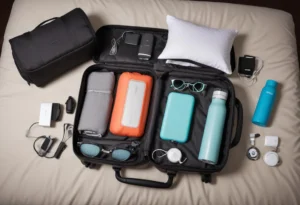As people around the world become more aware of environmental issues, many travelers are looking for ways to reduce their impact on the planet. Eco-friendly travel means making sustainable choices that help protect the planet, keep natural resources safe, and help local communities. No matter the length of your trip, there are many things you can do to travel more consciously. Here are the best eco-friendly travel tips you need to know to make your trip greener and longer.
Choose Eco-Friendly Travel Options:
Choosing the mode of transportation that has the least impact on the environment is the first thing you can do when traveling eco-friendly. One of the biggest sources of carbon emissions is air travel, but for long-distance travel, this often cannot be avoided. If you have to fly, try to find a direct flight. This is because most of the pollution from planes comes from takeoff and landing. If your trip is shorter, you may have to take a bus, train, or ride-sharing service. Trains are particularly good for the environment, because each person produces far less carbon dioxide than cars or planes. Whenever possible, you should choose transportation options that are better for the environment.
Choose an Eco-Friendly Place to Stay:
Where you stay while traveling can have a big impact on the planet. The average hotel or resort uses a lot of water and electricity, which has a huge impact on the earth. You can stay at eco-lodges, sustainable hotels, and local guesthouses, which are greener options. In these places, it is important to use green energy, conserve water, and reduce waste. Some eco-friendly hotels are very environmentally friendly and have certifications such as Green Key or LEED, which show that they meet sustainability standards. You can help the environment and companies that care about sustainability by choosing an eco-friendly place to stay.
Smart Lightweight Packing:
Packing less stuff while traveling is an easy way to help the environment. Especially when you fly: the bigger your bags are, the more fuel your vehicle needs to transport them. By packing only what you need and not too much, you can reduce the weight of your luggage. Bring reusable items like water bottles, shopping bags, and travel essentials to reduce single-use plastic waste. Biodegradable soap and shampoo bars are more environmentally friendly than plastic bottles, so you may want to keep them with you. Yes, traveling light is not only better for the environment, but it can also make your trip easier and less stressful.
Care for Nature:
Eco-friendly travel also means caring for the wild world. Follow Leave No Trace rules when visiting nature reserves, beaches, forests, and other natural areas. The rules tell travelers to minimize damage to the environment by staying on marked trails, not disturbing wildlife, and picking up trash. Don’t do things that harm the animals or the ecosystem, such as elephant rides, going to poorly managed zoos, or wildlife tourism where animals are exploited for profit. When you’re in nature, being mindful of what you do can help protect these places for future generations.
Help Local Communities:
Sustainable travel isn’t just about leaving less of a footprint on the earth; it’s also about helping the people who live in the places you visit. When you travel, look for restaurants, shops, and stores that are locally owned. Buying locally made goods and eating locally grown food helps the local economy and reduces the carbon footprint of transporting goods. Traveling and doing things with the people who live there can give you a more authentic experience while also directly helping the community. Choosing activities that care for the community and the environment is a great way to encourage sustainable tourism.
Save Energy and Water:
Saving water and energy is an important part of eco-friendly tourism. Doing simple things like taking shorter showers, using the same blanket more than once, and turning off the lights when you leave a hotel room can make a big difference. Many eco-friendly accommodations save energy by using low-flow shower heads, energy-saving light bulbs, and renewable energy sources. Travelers can also reduce their carbon footprint by living in places that use solar or wind power. Making small changes to what you do every day can help you save resources and learn lessons about the damage your accommodations do to the planet.
Consider Taking Your Time:
Adopting the concept of slow travel is one of the best ways to make your travels more environmentally friendly. Instead of taking a few short trips, consider staying longer in each place you visit. When you move slowly, you’ll travel less often by plane or car, which will reduce your overall carbon footprint. You can also learn more about the history of the area, visit places that aren’t on everyone’s list, and support local businesses. When you stay in one place longer, your travels will be more meaningful and have less impact on the world.
Choose an Eco-Friendly, Ethical Vacation:
Ensuring that what you do while traveling is fair and sustainable is another important part of eco-friendly travel. Before you book, research tour companies and tours to make sure they follow responsible travel guidelines. Stay away from things that could harm animals, the environment, or people living nearby. Instead, look for tours that help protect wildlife, support conservation efforts, or educate people about the environment. Doing the ethical thing allows you to enjoy your travels while helping to protect natural and cultural resources.
Conclusion:
When you travel in an eco-friendly way, the activities you choose are good for the planet and help people wherever you go. There are many ways to make your travels greener and more sustainable, such as choosing eco-friendly transportation, reducing waste, conserving resources, and supporting travel companies that do good. When you travel in an eco-friendly way, you can enjoy the beauty of the world while helping to preserve it for future generations. Everything that people do matters, and when they work together, they can make a huge difference for the better.
FAQs:
1. What kind of travel is eco-friendly?
When you travel eco-friendly, you choose to do things that have the least impact on the environment. For example, you can use sustainable transportation, reduce waste, and support local communities.
2. How can we take steps to reduce our impact on the environment?
You can reduce your carbon footprint by taking eco-friendly transportation, such as buses or trains, staying in eco-friendly accommodations, traveling light, and using items that can be reused.
3. What are some eco-friendly places to stay?
Eco-friendly accommodations are places like hotels and cabins that care for the environment by using renewable energy, saving water, reducing waste, and helping the local community.
4. What can I do to reduce waste when traveling?
Bring reusable items, such as water bottles, cloth shopping bags, and travel essentials, instead of single-use plastic items to reduce waste. Choose products that are good for the environment and recycle where possible.
5. What is slow travel?
When you move slowly, you stay longer and travel less in each place you visit. This will reduce your carbon footprint. It will also allow you to gain a better understanding of the culture and nature of the area, while reducing pollution from travel.




